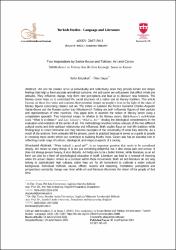| dc.contributor.author | Küçükali, Selin | |
| dc.contributor.author | Başar, İlkin | |
| dc.date.accessioned | 2023-05-24T10:53:57Z | |
| dc.date.available | 2023-05-24T10:53:57Z | |
| dc.date.issued | 2021 | en_US |
| dc.identifier.citation | KÜÇÜKALİ, S., & BAŞAR, İ. (2021). Two Inspirations by Sainte-Beuve and Tolstoy: Art and Canon. Turkish Studies-Language and Literature, 16(2), p. 1257-1267. | en_US |
| dc.identifier.issn | 2667-5641 | |
| dc.identifier.uri | https://hdl.handle.net/20.500.12960/1501 | |
| dc.description.abstract | Art and the classics serve us individually and collectively since they provide kinder and deeper feelings that help us form accurate and ethical concerns. Art and canon are soft powers that affect minds and attitudes. They influence change, help form new perceptions and lead as to discover new horizons. The literary canon helps us to understand the social structures of a nation and its literary tradition. This article focusus on these two terms and explores their potential impact on people’s lives in the light of the ideas of literary figures concerning classics and art. The critics in question the French humanist Charles-Augustin Sainte-Beuve and the Russian author Leo Nikolayevich Tolstoy are both influential figures of their periods and representatives of their countries. This paper aims to examine the notion of literary canon using a comparative approach. Two important essays, in relation to the literary canon, Saint-Beuve’s well-known work “What is a classic?” and Leo Tolstoy’s “What is Art?” display the ideological considerations in the evaluation and evolution of the works of art. The methodology involves textual analysis of the two different cultural works and their spiritual relationship and influences. Both studies focus on real-life tradition while finding keys in canon formation and they become examples of the universality of what they describe. As a result of the analysis, from antiquity till the present, canon is practical because it serves as a guide to people in choosing those works which can contribute to building fruitful lives. Canon also has an essential role in reflecting a wide range of cultural, ideological, and religious aspects of a society. | en_US |
| dc.language.iso | eng | en_US |
| dc.publisher | Turkish Studies - Language and Literature | en_US |
| dc.relation.ispartof | Turkish Studies - Language and Literature | en_US |
| dc.relation.isversionof | 10.47845/TurkishStudies.48886 | en_US |
| dc.rights | info:eu-repo/semantics/openAccess | en_US |
| dc.subject | Dil ve edebiyat | en_US |
| dc.subject | Edebi çalışmalar | en_US |
| dc.subject | Sanat | en_US |
| dc.subject | Kanon | en_US |
| dc.subject | Klasikler | en_US |
| dc.subject | Sainte-Beuve | en_US |
| dc.subject | Tolstoy | en_US |
| dc.title | Two Inspirations by Sainte-Beuve and Tolstoy: Art and Canon | en_US |
| dc.type | article | en_US |
| dc.authorid | 0000-0002-2518-9255 | en_US |
| dc.department | Rektörlük, İngilizce Hazırlık Bölümü | en_US |
| dc.contributor.institutionauthor | Selin, Küçükali | |
| dc.identifier.volume | 16 | en_US |
| dc.identifier.issue | 2 | en_US |
| dc.identifier.startpage | 1257 | en_US |
| dc.identifier.endpage | 1267 | en_US |
| dc.relation.publicationcategory | Makale - Uluslararası Hakemli Dergi - Kurum Öğretim Elemanı | en_US |

















